Projects guns by Charles J. Manville (USA)
Work on the weapon, later received the general designation Manville Gun, started in the first half of the thirties. The American gunsmith decided to create a promising smooth-bore gun that could be offered to police units. The thirties were not the most peaceful period in the history of the United States, because of which the police needed powerful weapons to fight crime and quell riots. It was precisely this niche that the new development of C. J. Manville was to occupy.
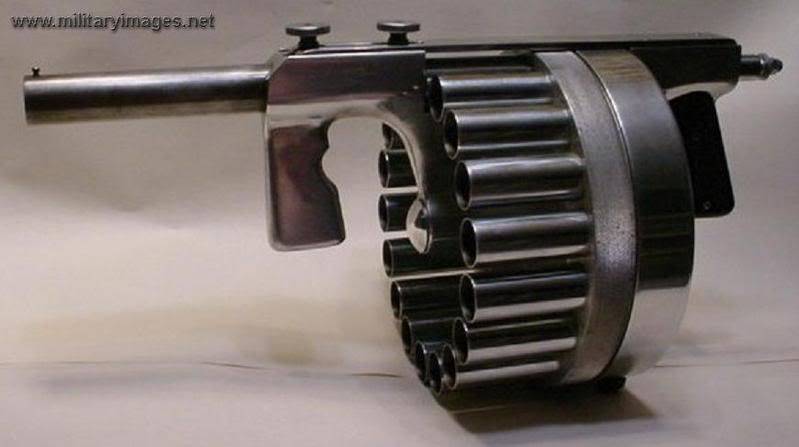
Shotgun Manville 26,5 caliber mm. Photo by Militaryimages.net
An analysis of the situation and the requirements of a potential customer led to the appearance of the appropriate appearance of the weapon. It was planned to create a 12 caliber rifle (mm 18,5) with a high-capacity magazine and the possibility of firing at a relatively high rate. Ammunition could include both gas cartridges and a canister. Thus, the promising gun allowed for a relatively long time to fire without the need for reloading, ensuring the performance of the tasks.
The fulfillment of such requirements did not allow the use of existing versions of the architecture of rifles, which is why Charles Manville had to build his weapon from scratch. The result of his work was the appearance of the original design of the weapon, resembling some other samples, but not having direct analogues in the history of small arms. The original features of a promising gun, above all, were associated with a wide borrowing of ideas from revolvers.
The development of the first shotgun was completed at the very beginning of 1935. On March 11, the inventor sent an application to the patent bureau to register its development. Shortly thereafter, the production of the first prototype began with its subsequent testing.
In his project, C. Manville used several existing ideas, as well as a number of original innovations. As a result, an unusual weapon appeared, the prospects of which could be the subject of fierce disputes. Nevertheless, the author continued to work on the project and later even developed several modifications of it.
The overall architecture of the gun of Manvilla looked as follows. In front of the trunk was located and some kind of forearm with the front handle. Behind the barrel was provided a drum shop, behind which was a receiver with a trigger mechanism. Sights, as well as the butt, were not used. Fire was offered from the hip and without prior aiming.
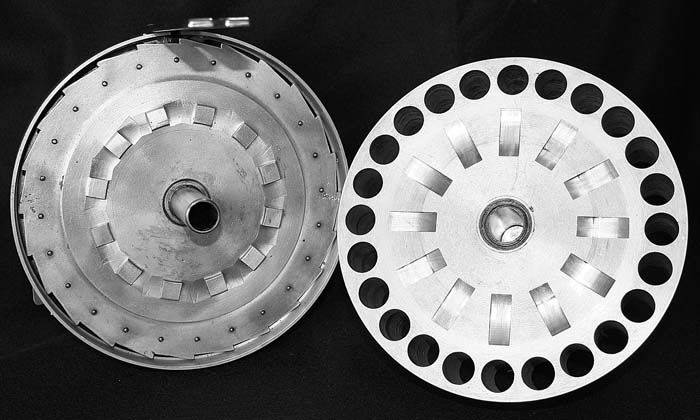
Shop first shotgun disassembled. Photo by Smallarmsreview.com
Perhaps the most original idea of the project of C. Manville was the division of the gun into two main units, which should be separated for reloading and reattached before using. Due to such an original idea, the gunsmith was able to somewhat optimize the process of reloading, as well as simplify the design of the shop. So, when using a one-piece design, individual units of weapons could be too complicated.
The basis of the front unit guns Manvilla was a metal part of a special form with fixtures for the barrel and the store. In the upper part of the U-shaped parts there was a hole for mounting the barrel. In addition, two small threaded holes were provided in its upper surface, into which two screws were screwed in to connect the half of the weapon. The front vertical element of the U-shaped part was used as a handle and had the appropriate shape. The back one, in turn, was the fastening of the store, for that there was a ring in its lower part.
In the ring of the U-shaped part, it was proposed to place a tube that served as the axis of the magazine. At the same time, only the front half of the drum shop was fixed on it. The latter was a cylinder of aluminum alloy, in which there were 24 chambers for 12 caliber cartridges. To facilitate the design, there were grooves on the side of the drum. Behind the drum had a solid bottom, which is connected to the tube-axis. Several grooves were made on the back surface of the bottom.
The main part of the rear gun unit was a metal receiver, equipped with a pistol grip and fasteners for the rear of the magazine. A characteristic feature of the unit was the presence of a long cover, in front of which there was a longitudinal slot. When assembling weapons, the lid had to rest on the upper part of the U-shaped base of the front unit and be fixed in place with two clamping screws.
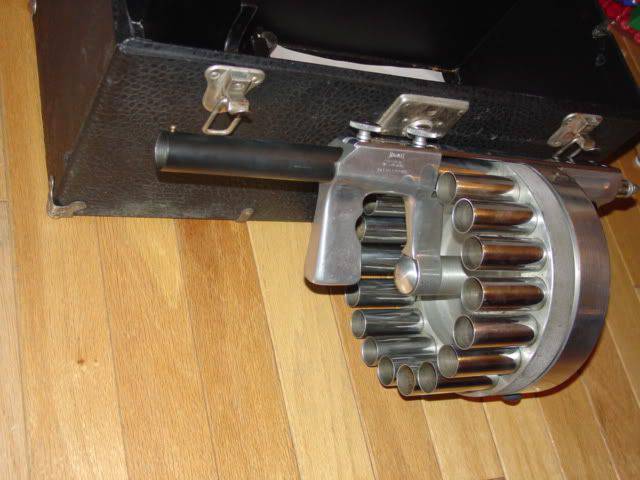
Shotgun second version with storage container. Photo Strangernn.livejournal.com
The back of the store was equipped with mechanisms for turning the block with chambers, as well as a set of drummers for making shots. This part of the store had a cylindrical body with a bottom, in the center of which was provided a tube-axis in contact with the spine of the front unit of the gun. Also, this tube was the axis for the store's own mechanisms. A special gear wheel connected with a spring rotated around it. Wheel movements were limited to a stopper connected with the trigger. The wheel had several holes located at the level of the centers of the chamber for the cartridges. They were fixed small drummers. In addition, several protrusions were provided on its front surface for contact with the recesses of the drum with the chambers.
All parts of the firing mechanism were located in the rear gun assembly. The main detail responsible for the shot was the trigger, made in the form of an elongated unit and placed in the cavity of the receiver. In the front part of it there was a device for contact with the drummers of the store, in the back there was a thrust brought out through the rear wall of the receiver and equipped with a handle. Around the spring was located combat spring. In the cocked position, the trigger was fixed by the sear, connected with the trigger. The handle has a special shape with a pair of side projections. In the normal position, these protrusions entered the side slots of the sleeve on the rear wall of the receiver, through which the thrust passed. Initially, the trigger had no fuse, but in the future such a device still appeared. To lock the trigger, it was necessary to pull the trigger knob and turn it on 90 °, after which its stops would become on the side surface of the sleeve and prevent the mechanisms from working.
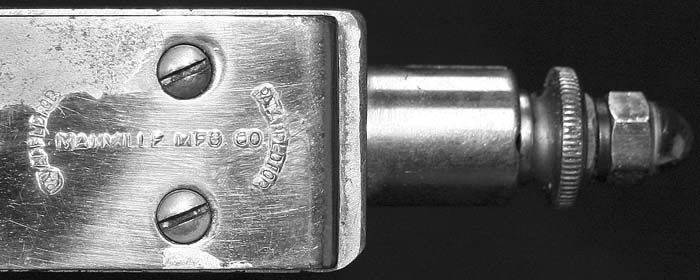
The back of the receiver and the protruding part of the trigger. Photo by Smallarmsreview.com
To use a gun H.J. Manville shooter first had to make loading. For this it was necessary to unscrew the two clamping screws and separate the weapon, opening access to the chambers. Then the cartridges of the required type were placed in the drum, after which the front half of the weapon should be put aside and the rear should be engaged. It was necessary to cock the spring of the store and put it on the lock, as well as lock the trigger in the rear position. Then it was possible to connect the weapon, fixing the units with two upper screws.
Before firing, it was necessary to cock the trigger and unlock the trigger. When the trigger was pressed, the gear of the magazine was unlocked, which, under the action of a spring, turned and led the next cartridge to the barrel. After that, a special USM threw the trigger back, let go and he hit the drummer, firing a shot. For the next shot, you had to pull the trigger again, thereby turning the drum and cocking-pulling the trigger. A characteristic feature of the mechanisms used was an excessively large force on the trigger. Automatic extraction of liners was not provided for: the shooter had to remove them himself during the reloading of the weapon.
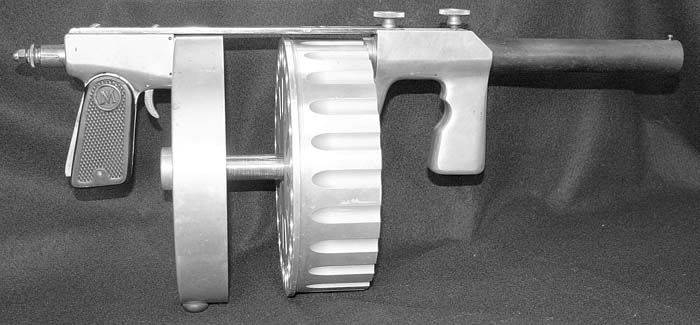
Gun caliber 26,5 mm, units apart. Photo by Smallarmsreview.com
Shotgun Ch.J. Manville of the first version was equipped with a relatively short barrel - 280 mm (11,1 inches), which seriously limited its characteristics, although it increased the mobility of the shooter due to weight reduction. Requirements relating to the mobility of a fighter, also led to the abandonment of the butt and, ultimately, from sighting devices. As conceived by the inventor, a new gun should have been fired from the hip and without aiming. Indeed, in shooting with criminals or during the dispersal of demonstrations, aimed shooting was useless. Gas cartridges and canister, proposed for use with a new weapon, allowed to shoot only in a certain direction, without worrying about accurate guidance.
Despite the extremely bold and unusual design, the promising gun met the requirements for it and had some prospects. However, the potential customer was not interested in this development. This decision was affected by the characteristics of the proposed ammunition. Thus, the use of grapeshot for protesters was unacceptable, and the cartridge with gas "stuffing" had an insufficient range of action. Thus, the arrow with the gun of Manville would have to approach the unruly crowd at a dangerously close distance. As a result, a promising gun could not find use in the police.
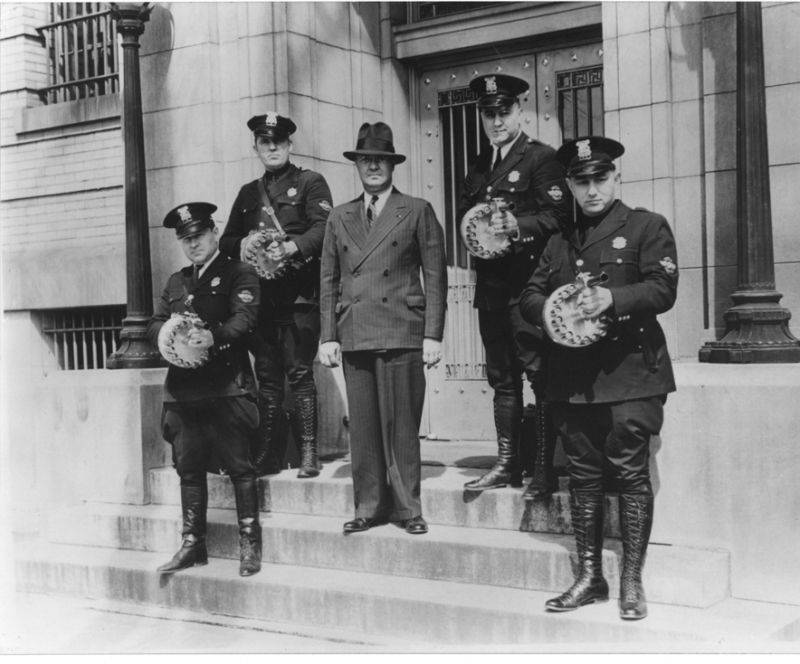
Charles J. Manville (center) and police with guns of his design. Photo Museumamericangangster.tumblr.com
The author of the project was refused, but did not give up. Already in the 1936 year, he presented a new version of his gun, reworked for a different cartridge with higher performance. The second version of the gun differed from the base caliber only and ready for use of ammunition. He received an 4 caliber barrel with a channel with a diameter of 26,5 mm (according to other data, 25 mm), which corresponded to the existing signal rockets. Because of this, in particular, the second version of the gun of Manville is often referred to as the Flare Gun ("Signal rifle"). The use of a new caliber made the inventor update some parts, as well as reduce the ammunition to 18 cartridges. At the same time, the overall architecture of the weapon remained the same, and even the external differences were minimal.
In the caliber 26,5 mm, smoke and signal cartridges already existed. Especially for the new gun was created and a gas grenade in a similar design. Its volume and other characteristics already allowed to shoot at a reasonable distance. Thus, the modified weapon could already be used in practice. However, after the modifications, the gun lost its ability to use the existing cartridges. According to some reports, this problem was solved by creating a set of liners and inlays for the chambers, with which the weapon could use 12-caliber ammunition.
In the near future, the 26,5-mm rifle underwent a small upgrade, during which several details were refined. All changes were related to production technologies or the convenience of using weapons. The guns of the two versions were produced in small batches and were supplied to various power structures, including the police and the National Guard. There are several known cases of using such weapons against strikers. In all these cases, the security forces used signal cartridges and also fired at the crowd with gas munitions.
At this development of the structure has not stopped. In 1938, JJ Manville introduced the third version of his gun, now chambered for 37x127 mm R. The overall architecture of this model remained the same, but the design had to be significantly reworked due to the increased power of ammunition. So, instead of an elongated receiver cover, a large and durable metal pin was now used to connect the units. The front U-shaped part with the handle was reinforced, and its shape also changed. Finally, instead of a single cylindrical block with drilled chambers, a metal plate with tubes of the required diameter welded to it was used. A significant increase in caliber again led to a reduction in ammunition. In the drum of the third version of the Manville Gun, only 12 ammunition was placed.
Large caliber allows to consider the Mannville 37-mm gun as a full-fledged grenade launcher, however, despite this, the weapon retained the name of its predecessors. In the updated version, the gun was again put into a series and expanded to the arsenals of various power structures. An interesting consequence of a large caliber were orders that prohibit firing from an 37-mm rifle-grenade launcher by fighters with insufficient physical training or without using bipods, installations, and other similar equipment.
According to reports, since the beginning of the forties, the United States arsenals continued to develop the design of Charles J. Manville. The result of this was the appearance of modifications based on the latest version of the gun and differing in the caliber of the barrel. There were options with barrels of caliber from 18,5 mm to 40 mm. Various versions of these weapons are still in service with US law enforcement agencies and are used as non-lethal weapons to disperse crowds. At the same time, according to some data, 37-mm systems are the most popular. Due to their caliber, they have high enough characteristics, but they cannot use 40-mm lethal ammunition. As a result, the possibility of an erroneous attack with the use of lethal ammunition is excluded.
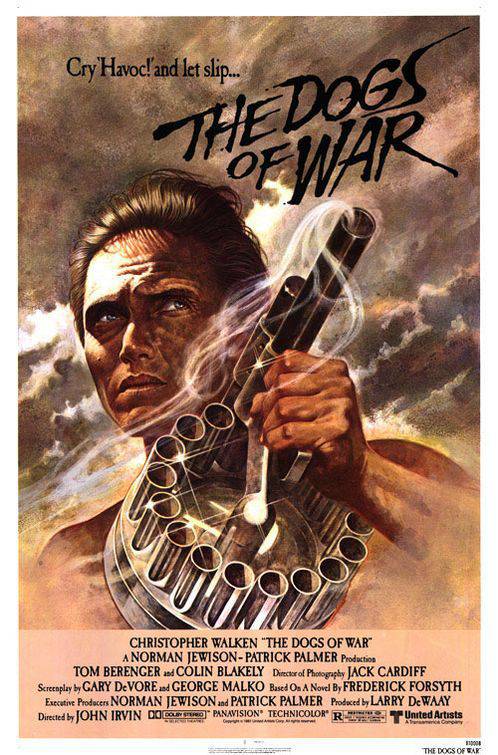
Poster of the movie "Dogs of War", the hero holds a version of the gun Mannvil in 12-caliber. Photo Imfdb.org
Having received a wide distribution in the police and the National Guard under, the guns of Manville could not help but interest the filmmakers. Over the past few decades, these systems appear regularly in films and are used by movie heroes. At the same time, the first appearance of the gun, which took place in the film “Dogs of War” (dir. John Irwin, 1980), is of the greatest interest. The protagonist of this picture used a variant of the 12 caliber gun, designated as XM-18E1R. Unlike the real model, this system had higher range and fire performance. In addition, according to the heroes, ammunition could include fragmentation, gas, anti-tank and other ammunition, including items with arrow-shaped striking elements. As often happens, the characteristics of a fictional sample were higher than that of a real prototype.
The projects are based on C.J. Manville were original and bold ideas, which, however, could put an end to development. Nevertheless, the inventor managed in practice to prove the viability of his ideas and even to sell new weapons to American law enforcement agencies. Since the thirties, Manville Gun rifles were repeatedly upgraded, during which they received certain new features, as well as improved their characteristics. Guns, based on the ideas of Manville, are still used in various structures of the United States and, it seems, will not soon go to the scrap. Thus, not all too original and bold projects remain in history only as technical curiosities.
On the materials of the sites:
http://forgottenweapons.com/
http://smallarmsreview.com/
http://imfdb.org/
http://museumamericangangster.tumblr.com/
http://strangernn.livejournal.com/
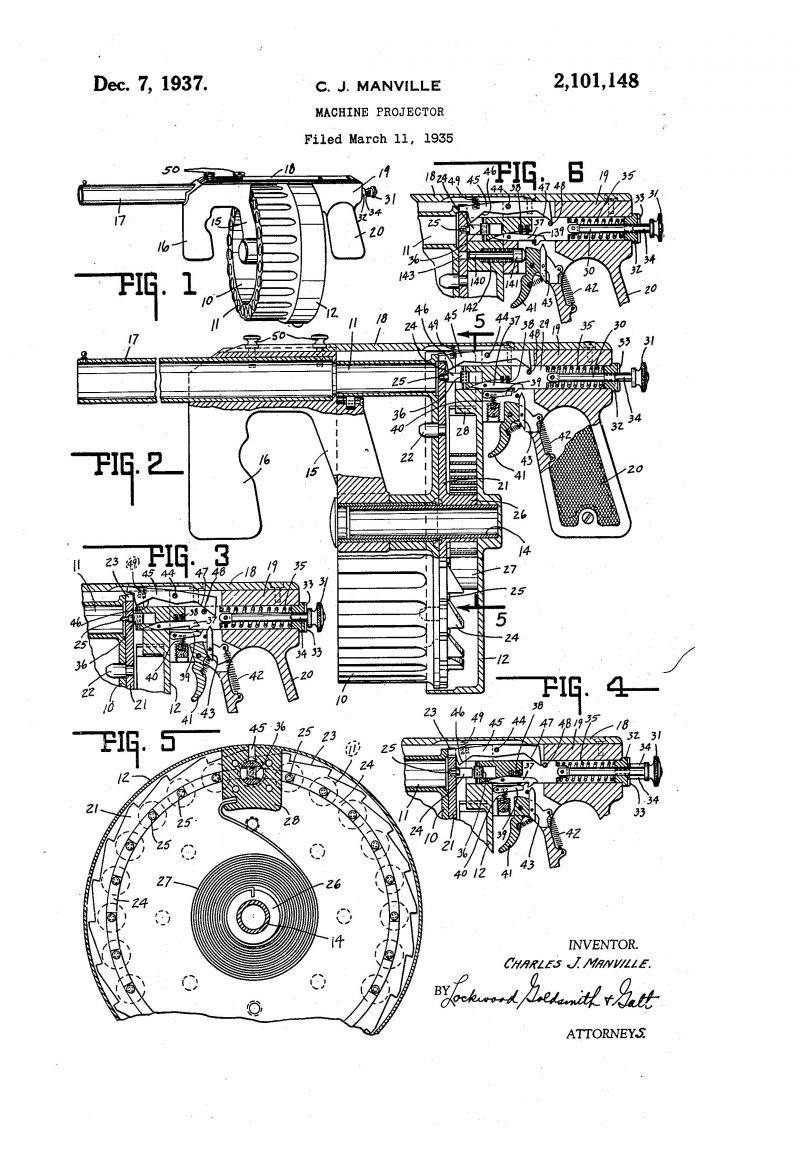
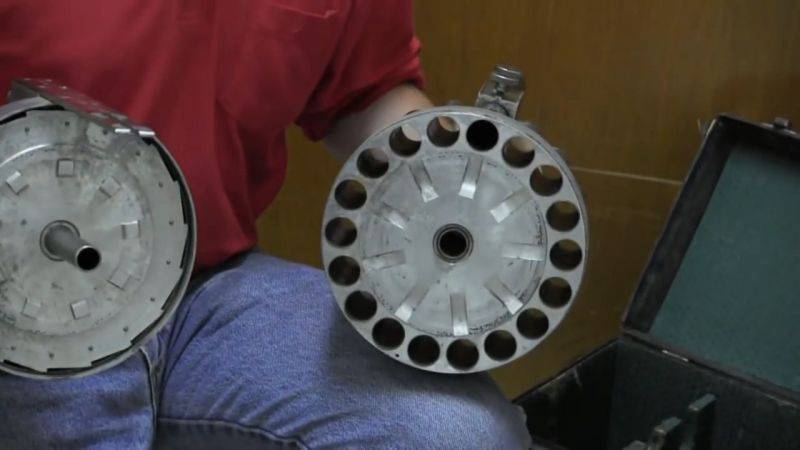
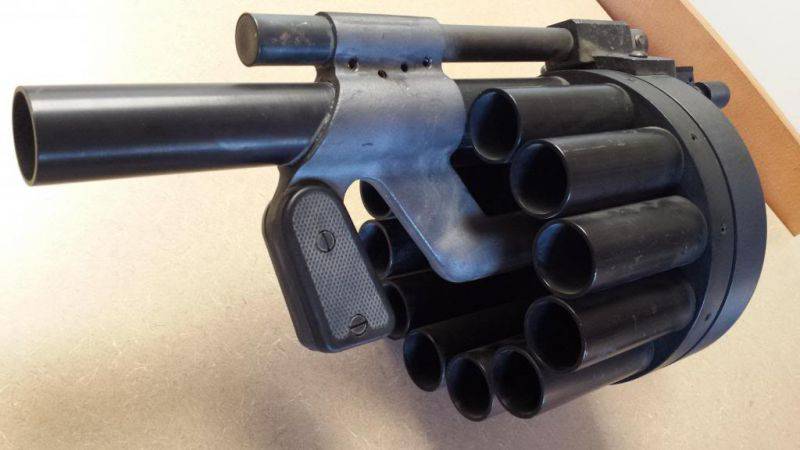
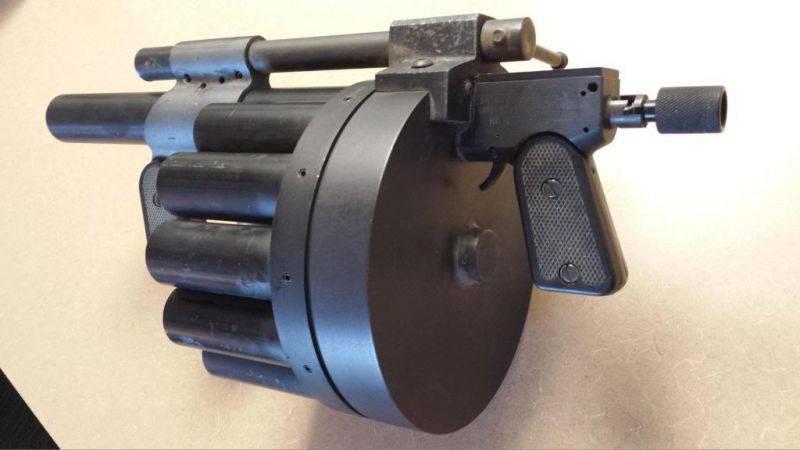
Information